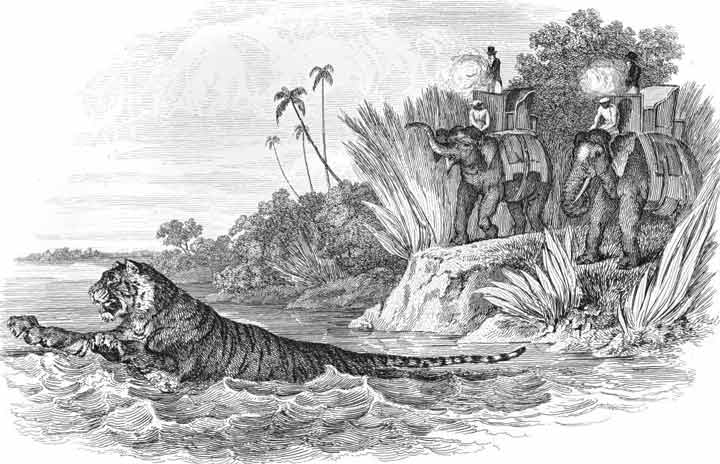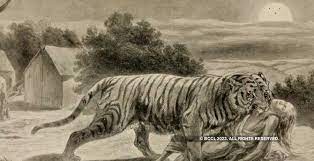|
|
Post by tyrannasorus on Nov 7, 2023 18:01:22 GMT 5
A thread for discussing man-eaters, why they become so and to discuss the various infamous man hunters throughout history
|
|
|
|
Post by tyrannasorus on Nov 7, 2023 18:10:13 GMT 5
A man-eater is an animal that preys on human beings, not scavenging or a single attack on a human out of desperation or self-defence(although these serve as starting points in many cases).
While many animals can kill and eat humans, Man-eaters are those that have incorporated humans into their diets and actively seek out and hunt them.
Most notable species that are attributed as man-eaters are lions,tigers,leopards,bears and large crocodilians.
In most cases, it is an injury caused to the animal, whether by humans or by natural methods which makes them unable to hunt their regular prey, forcing them to prey on people
|
|
|
|
Post by tyrannasorus on Nov 7, 2023 18:38:29 GMT 5
lets start with one of the more famous ones THE DEMON OF CHAMPAWAT  The Demon of Champawat was a Bengal Tigress responsible for an estimated 436 deaths in Nepal and the Kumaon division of India, during the last years of the 19th century and the first years of the 20th century, which is the highest kill count of any animal in human history The Demon of Champawat was a female Bengal tiger that lived in Nepal in the late 1890s, when the killings began. Her first victims were villagers living near the Himalayas in western Nepal. Back then, tiger and leopard attacks weren’t uncommon as many big cats were facing a decrease in prey populations via overhunting by humans as well as habitat loss, resulting in some seeking out human prey. But the Champawat Tiger was different, and as the death toll began to rise rapidly, the Nepal government realized they had to do something. They started by sending in hunters to take care of the feline, but it cunningly evaded them all. Becoming desperate, they called in the Nepalese army. They made several attempts to kill or trap the predator, but each one failed. Eventually, they gathered all their troops and surrounded the tiger’s territory, then began to march into the jungle with guns at the ready. With no way out, the tiger seemed finished, except for one thing: bordering the territory was a river that separated Nepal from India. Tigers are strong swimmers, so it simply swam across the river and escaped the army, now entering India.  Once here, she quickly resumed her killing spree, slaughtering uncountable dozens of people. Attacks occured almost daily with most of her victims being the young, old or sickly. The killer also had an unusual behaviour for a tiger, since most would have established a territory around the most populous hunting grounds and defended their territories from invaders. instead she hunted across a very wide area, and would travel long distances between kills, sometimes up to 20 miles. This ensured she never attacked the same place too many times, and it also made tracking her much harder for hunters. As well, while most tigers prefer to hunt either at night or at dawn or dusk when there’s less light, the Champawat Tiger brazenly attacked its victims in broad daylight. Her booming roars echoed across the landscape, scaring people so much that grown men refused to leave their homes to go to work, paralyzed with fear that the creature would take their life if they dared to step out Eventually, famed hunter and conservationist Jim Corbett heard the news of the man eater and decided to investigate, Corbett had made a name for himself by hunting down other man eating big cats, including both tigers and leopards. He specialized in man eaters and could often tell the cause for their hunting humans, such as starvation or crippling injury.  His first hunt for the Champawat Demon was after it had killed a young girl outside the village of Fungar. He discovered her half eaten body, but while investigating the tigress burst out of the nearby bushes and charged him. He shot at it with his rifle, missing twice but successfully scaring it away. The next day, he organized an operation with the villagers of the neighboring town Champawat. Just like the Nepalese Army, they planned to push the tiger into the open with a massive wall of people. The plan was a success, and Corbett had it in his sights. He opened fire, hitting the man eater in the shoulder. The wounded tiger once again charged him, but the sound of the beat made it reconsider and retreat. He tracked it down quickly and managed to shoot it once more in the chest. The tiger, mortally wounded and angry charged him, only for him to realize that he was out of bullets. Thinking quickly, he grabbed a rifle from a nearby villager and fired once, hitting her in the paw and causing her to collapse. She quickly succumbed to the bullets, 20 feet from where Corbett stood  A postmortem on the tigress showed the upper and lower canine teeth on the right side of her mouth were broken, the upper one in half, the lower one right down to the bone. This injury, a result of an old gunshot, according to Corbett, probably prevented her from hunting her natural prey, and hence, she started to hunt humans.Further examinations made by Corbett during his hunt for the tiger indicated that she was in healthy condition physically (other than her teeth) and was between 10 and 12 years old. More details of the hunt and on many other man-eaters can be found in Jim Corbett's book "Man-Eaters of Kumaon". |
|
|
|
Post by Infinity Blade on Nov 7, 2023 20:13:12 GMT 5
I have a book about the Champawat maneater that I bought a year ago. I've still yet to finish it, and this thread reminded me that I should.
|
|